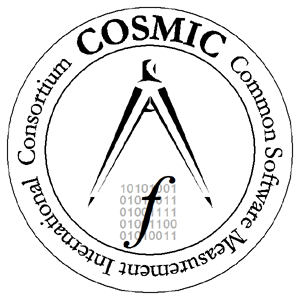Workshop organizers
Professor Alain Abran
Ecole de Technologie Superieure, Montréal, Canada
Assistant Professor Cigdem Gencel
Free University of Bozen/Bolzano, Italy
Jaroslaw Swierczek
300 D&C, Warsaw, Poland
Charles Symons
Chair COSMIC Measurement Practices Committee, UK
Chris Woodward
CW Associates, UK
Purpose of the Workshop
To provide an opportunity for practitioners of the COSMIC method and newcomers to learn about the latest developments and thinking in the evolution of the COSMIC method.
Version 4.0 of the COSMIC method
The Measurement Practices Committee continues to improve the description of the COSMIC Functional Size Measurement method, whilst preserving the method’s fundamental principles, with the aims of easing understanding and hence ensuring greater consistency in the method’s use. The most important changes in version 4.0 of the method are i) in the improved description of the chain whereby an event causes a functional user to generate a data group that is moved by a triggering Entry into a functional process, and the resulting definitions of these concepts, and ii) the improved definition of a software layer, which is now in line with industry usage. The first group of these improvements enables, for example, a better definition of a functional process that should prevent a possible misinterpretation, and a better description of how to analyse and measure batch-processed functionality.
This session will outline the main changes made to the version 4.0 of the Measurement Manual compared with the previous v3.0.1, explaining why the changes were needed. We will also briefly introduce two new Guidelines on ‘Convertibility’ and on ‘Approximate Size Measurement’ resulting from the upgrade to v4.0 of the method, and improvements to other Guidelines that can be made as a result of, for example, the improved definition of a layer.
The COSMIC approach to dealing with Non-Functional Requirements
The primary uses of COSMIC FSM are in
- measuring a size of software as the work-output of completed software projects and hence enabling the measurement of their performance, and
- in using size estimates and past performance data to estimate the effort for new projects.
Whilst size is usually the main driver of effort, many other factors cause variations in performance and the same factors must be taken into account in estimating effort for new software projects. These ‘other factors’ are often referred to as ‘Non-functional Requirements’. A difficulty is that there is a very large number of possible NFR, no useful common definition of what is a NFR, and no agreement on how to take them into account in performance measurement and estimating.
In this session we will present the COSMIC definition of NFR, a classification system and glossary of NFR based on International Standards, and the COSMIC-recommended process for dealing with NFR in project performance measurement, benchmarking comparisons, and project estimating. The presentation will include examples of how NFR may evolve as a project progresses, wholly or partly into functional requirements for software that can be sized with the COSMIC method. This topic is a work-in-progress that will lead to a new COSMIC Guideline.
Automating COSMIC measurement of specifications held in UML
In this session we will describe the latest work on the rules and processes for automating COSMIC FSM of specifications held in the Unified Modelling Language, to be published in a new Guideline.
Project estimating with COSMIC
In this session we will present various views of software project effort and duration estimation that both estimators and managers must be aware of when designing and using estimation models for decision-making. We will describe the structure of an estimation process, including the productivity models embedded in the estimation process, and will clarify the distinct roles and responsibilities that estimators and managers have. A number of estimation models built with COSMIC data from industry will be presented and discussed.
We will look at estimation models from an engineering perspective, not from a ‘craft’ perspective: the various parts of an estimation process must be understood and verified when building and using estimation models. The focus will be on the concepts and techniques necessary for understanding that the quality of the outcomes of an estimation process depends on the quality of its inputs, of the underlying productivity models it uses, and an understanding of the limitations of the ‘other factors’ used as adjustments for estimation purposes.
COSMIC website
Participation
If you want to participate in this workshop, you have to register to the conference for at least the day of the workshop. If you already registered to the conference, you can attend to this workshop free of charge.
Date & time
Monday, October 6
9.00 – 12.30 Noordam room (B-deck)
Note! This workshop coincides with another workshop: IT Confidence. It also coincides with the Nesma CFPA Exam.

